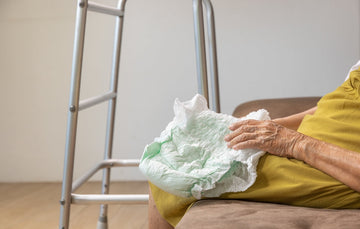
Diaper rash isn't just a concern for babies. Adults who use wheelchairs, especially those with limited mobility, can also experience this uncomfortable and sometimes painful skin irritation. Fortunately, understanding the causes, prevention strategies, and treatment options can help keep skin healthy.
What Causes Diaper Rash in Wheelchair Users?
Diaper rash, also known as diaper dermatitis, is a common skin irritation that appears as redness, inflammation, and sometimes small bumps or blisters.
- Prolonged Moisture: Wheelchair users often spend extended periods sitting, which can trap moisture in the diaper area. This moisture creates a breeding ground for bacteria and fungi, leading to skin irritation and breakdown.
- Friction: The constant rubbing of the diaper against the skin can cause friction, especially if the diaper is too tight or the material is irritating.
- Urine and Feces: These bodily fluids can further irritate the skin, especially if left in contact for too long.
-
Sensitive Skin: Some individuals have naturally sensitive skin, making them more susceptible to diaper rash.

Effective Treatment for Adult Diaper Rash
Treating diaper rash promptly is crucial to alleviate discomfort and prevent complications. Here are essential steps:
- Cleanse Gently: Wash the affected area with lukewarm water and a mild, fragrance-free cleanser. Avoid harsh soaps and scrubbing, as this can worsen the irritation.
- Dry Thoroughly: Pat the skin dry with a soft towel. Avoid rubbing, as it can cause further friction.
- Apply Barrier Cream: Apply a thick layer of a barrier cream, such as Soreze Adult Diaper Rash Gel, to protect the skin from moisture and irritants. Soreze is specifically formulated for adults, providing soothing relief and promotes healing.
- Change Diapers Frequently: Frequent diaper changes are essential to keep the skin clean and dry.
Read Also, How To Choose Right Adult Diapers to Minimize Diaper Rash Risk?
Prevention is Key
Preventing diaper rash is always preferable to treating it. Here are some proactive measures:
- Choose Breathable Diapers: Opt for breathable diapers that allow air circulation and reduce moisture buildup.
- Use Barrier Cream Regularly: Apply Soreze Adult Diaper Rash Gel with each diaper change to create a protective layer on the skin.
- Maintain Skin Hygiene: Keep the skin clean and dry by practising good hygiene.
-
Change Positions Frequently: If possible, change positions regularly to relieve pressure points.

Soreze Adult Diaper Rash Gel: Your Skin's Best Friend
Soreze Adult Diaper Rash Gel is a powerful ally in the fight against diaper rash. It is a scientifically designed Diaper Rash gel for adults and uses patented Silicone-based barrier gel technology that blends with the goodness of natural essential oils and silicone elastomers to treat and prevent diaper rashes in adults due to incontinence or underlying medical conditions.

When to Seek Medical Attention
While most diaper rash can be managed at home, consult a healthcare professional if:
- The rash doesn't improve within a few days of treatment.
- The rash appears infected (oozing pus, red streaks).
- The person has a fever or seems unwell.
Additional Tips for Wheelchair Users
- Consider using absorbent pads or briefs to help manage incontinence.
- Choose diapers made from breathable materials.
- Maintain good hygiene by showering or bathing regularly.
- Consult a healthcare professional for personalized advice and treatment.
By taking a proactive approach to prevention and understanding treatment options, you can effectively manage diaper rash in wheelchair users, promoting skin health and overall well-being.
Disclaimer: This blog post is intended for informational purposes only and should not be considered a substitute for professional medical advice. Consult a healthcare professional for any concerns about diaper rash or skin irritation.


